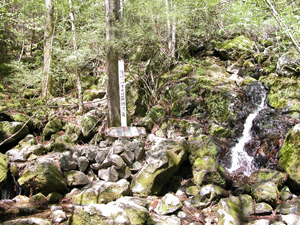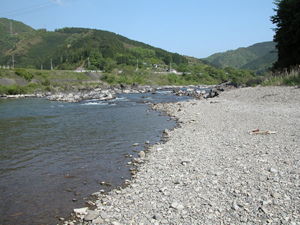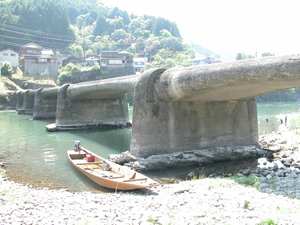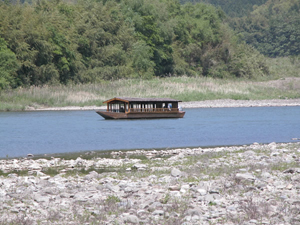
Shimanto River in Shikoku Island in Japan is called the last limpid river in the country. Aside from being limpid, the river is precious in that it is closely linked to the lives of the local people. The river still reflects well the nostalgic culture of Japan, how people used to live side by side with a river.
|
Although I have never lived in Shikoku Island, I frequently visit the place. The other day, I had a chance to closely observe Shimanto River, the second longest river in the island. What impressed me the most in my tour from the source of the river down to the mouth was that the river is severely winded all through the way. I felt as if I am watching a scale back of a great river in a large continent. Since the river originates deep into a mountain, the flow at the source is rapid but it soon slows down and starts meandering. The river once approaches a shore as close as 8km but crawls back to inland and meanders around quite a long distance before it finally flows into the Pacific Ocean. While I was checking stones and sand in the riverbed, I noticed something unusual. The riverbed is largely full of small stones and it was not easy to put together even a handful of sand. Why on earth is it? A considerable reason is the small catchment area caused by the meandering, which is attributable to the following two factors. A river meanders when it runs through a plain without a big inclination. Meandering river accumulates more than it carries or erodes. It is natural for such rivers to accumulate a good deal of sand. However, Shimanto River originates in steep place deep into the Shikoku Mountain Range, and the area it runs is narrow. The river has small area to erode, in other words, source of sand supply is quite limited. The total catchment area of the river is 2,270 square kilometers and the length is 196 kilometers, or 12 square km/km. This is the smallest ratio of area for the length, among all the major rivers in Japan. The smaller the catchment area per a certain length is, the smaller amount of sand the river can carry. Additionally, since Shimanto River is severely meandered, it does not have enough strength to smash rocks into pieces along the way. The river may carry and erode severely in times of flooding but as it subsides, sand, which is light and small keeps being carried away, while relatively large stones and rocks remain left at the bottom. This may be another reason that sand is scarce along Shimanto River. Since Shimanto River is left without going through human-caused changes such as to straighten its channels or construct large dams, it allowed me to make speculations mentioned above. Of course, the river is not completely free from the act of human being. The river has bank protection, floodgate, domestic wastes flow into it and empty bottles and other trashes are dumped in some places. Just because trashes are dumped in the river, it does not necessarily mean that nature is impaired. That is one of the traces of human lives. The existence is similar to a village in a mountain or a coppice forest. Wherever we inhabit, we benefit from nature and at the same time, we are next to threats posed by nature. We have tried to shun risks of natural disaster as much as possible and the efforts will continue. The question is to what extent people should exert its command and what viewpoints people should be based on in protecting ourselves from nature. More specifically, we need to consider carefully what kinds of merits and demerits we would receive in making decision, such as, whether to set up a bank protection or to straighten the river channel. We should not put top priority in avoiding a risk that we face at the moment. Making a choice based on a longer time scale from scores to even hundreds of years would keep us from taking ridiculous acts, which could finally drive us into the corner to have to recover the natural state all over again. Unfortunately, there are many examples of such cases involving rivers and seashores. Sustainability is a keyword when it comes to dealing with a river. We can find a good solution in the lives of our ancestors, where method of flood control had already been devised, allowing people to make the best use of the river, just like I found in Shimanto River. Our ancestors paid respect and put priority to the natural state of a river. If human being differentiates ourselves from the other animals for being a creature with wisdom, we should be clever enough to learn from lessons, and be able to devise a method to live with a river in harmony. 2003. July 1 |
|
 |
Shimanto River originates in eastern side of Irazu Mountain (1336m high) at 1200m high, located at the foot of Shikoku Mountain Range. After walking through a forest, I climbed a steep slope for about 20 minutes, when I found a sign indicating that the place is the river source. Water flows down from higher point than the place, but human access to the mountain is forbidden in higher place beyond the sign (the name Irazu means to keep off people). Because the river source is located at the southern slope of Shikoku karst, limestone is easily found in the riverbank. |
 |
The riverbank stones give out their innate luster for being polished by the river. Usually, large rivers in Japan have multiple dams in their upstream and stones in riverbanks do not move much even in times of heavy rain. Grasses grow in such places and people mess up by driving in riverbanks for camping and other activities. But Shimanto River maintained naturally formed order of stones. |
 |
Picture - 3 A boat used by a fisherman Fishermen still make their living by fishing in Shimanto River. Some use boats and others use nets or set traps to catch fish. Blessings of the river such as freshwater prawn, ayu (fish) and eel support the lives of local residents as well as provide source of enjoyment for the tourists. Thus, the river is vital for the local people. |

|
Shimanto River attracts tourists too. In the picture, an old-fashioned houseboat runs down the river carrying passengers. Other entertainment of the river includes rafting and canoe paddling. Children enjoy swimming and playing in the river. I have never encountered a sign, prohibiting a certain act in the river. Instead, I found one old sign proclaiming, "Anyone who pollutes the river will be criminally charged".
|
 |
Shimanto River flows into Pacific Ocean in Nakamura city, Kochi prefecture. Since there is a port at the left side of the riverbank, the bank is protected with tetrapods and concrete walls. A riverboat keeps operating near the mouth sending people from one side of the riverbank to the other. I met a child with his grandfather who said they were on their way to go fishing on the pier at the opposite side, on the riverboat. This is another example that the local people's lives are with the river.
|
Copyright of Image - 1 and 2 belongs to JSS and that of text and Picture - 1 through 5 belongs to Prof. Yoshiyuki Koide of Sapporo Gakuin University. Permission of JSS is required to their use for other purposes.